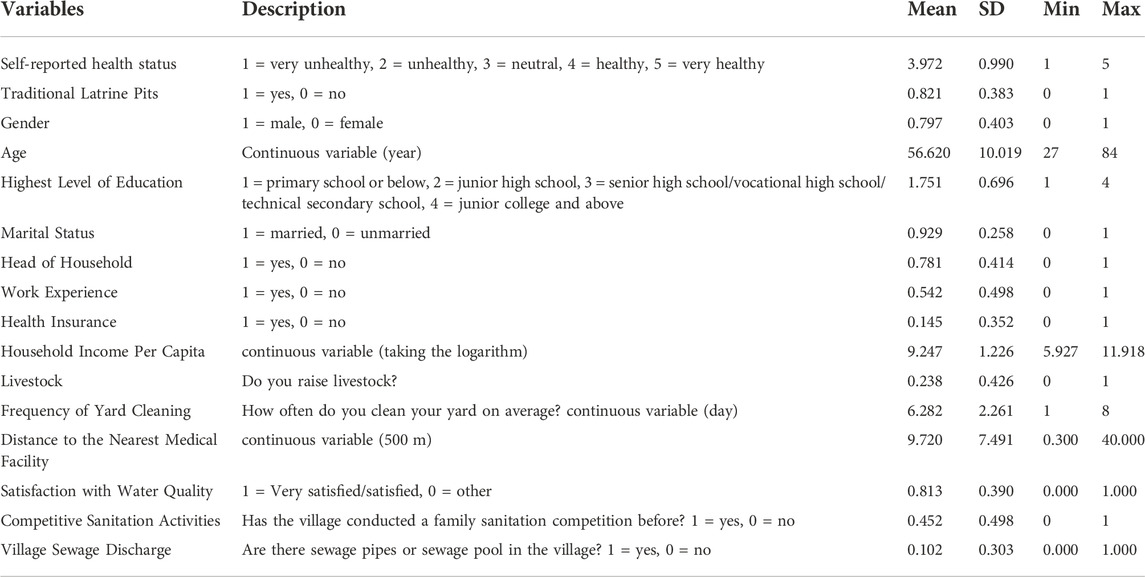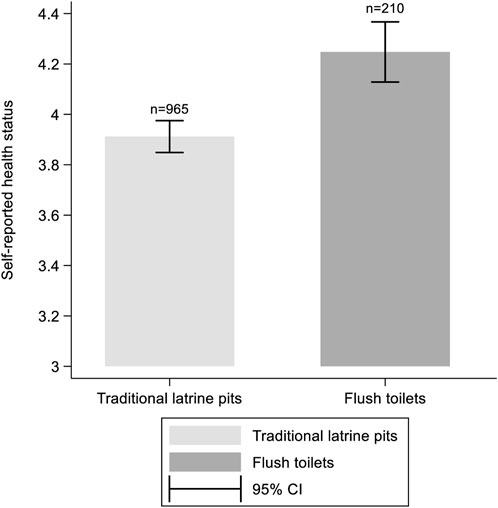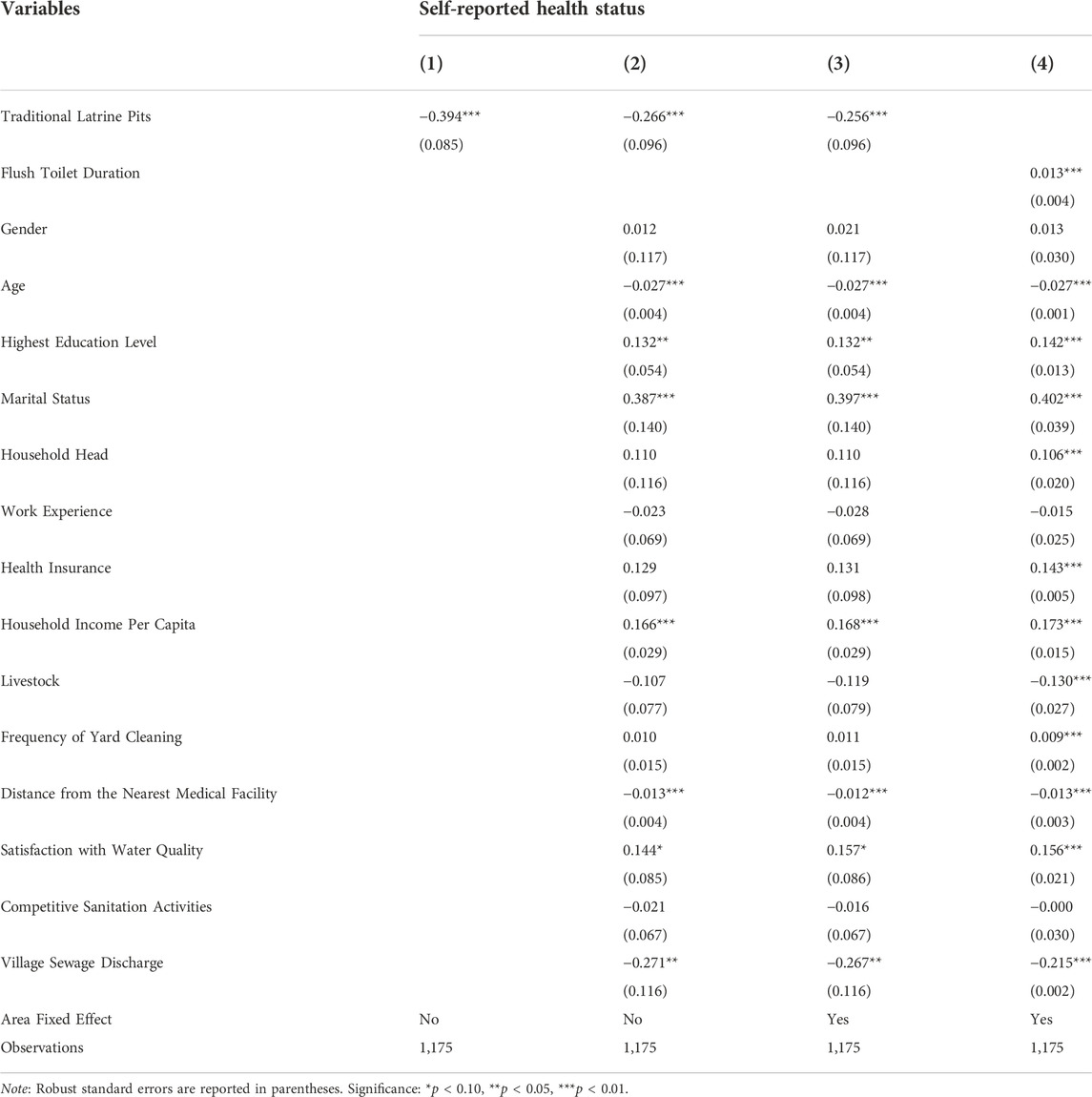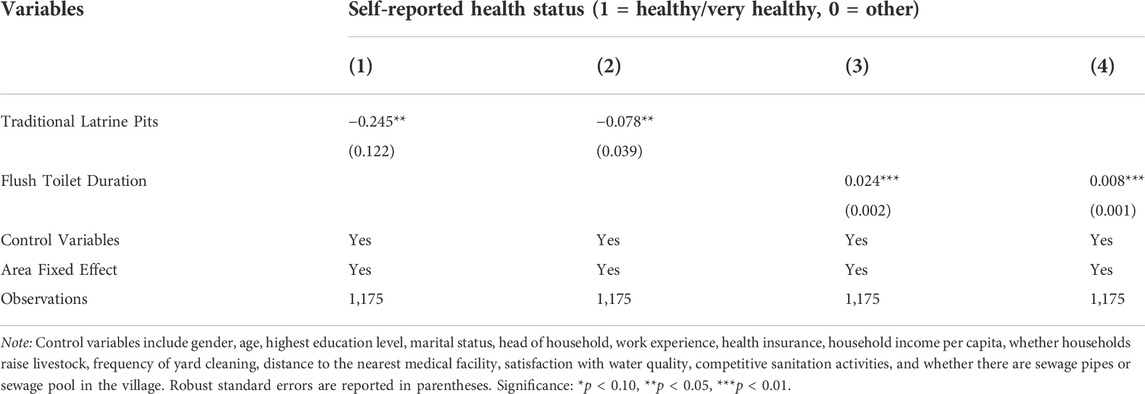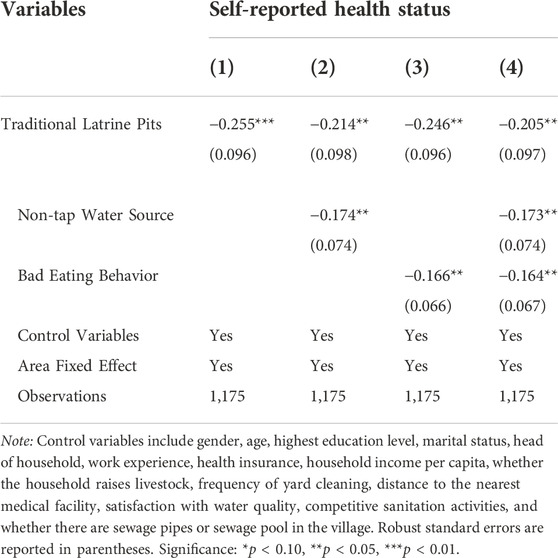- Shenyang Agricultural University, Shenyang, China
This paper uses field survey data from rural areas of Liaoning Province, China to investigate the relationship between sanitation and the health of rural residents. The results show that the use of traditional latrine pits is significantly negatively correlated with the health of rural residents. Robustness tests using Propensity Score Matching (PSM) further demonstrate the consistency of the results. Further research suggests that traditional latrine pits may affect the health of rural residents indirectly through the poor eating habits of rural residents and by polluting drinking water sources. Using the Life satisfaction approach method, this study concludes that the health value of flush toilets in the sample area accounts for 98% of annual per capita household income.
1 Introduction
Adequate sanitation is essential for good health and for social and economic development. According to the United Nations’ 2021 Sustainable Development Goals Report, the proportion of the global population using safely-managed sanitation services was only 54% in 2020. While substantial progress has been made in terms of increasing access to clean drinking water and sanitation, 3.6 billion people, mostly in rural areas, still lacked safely-managed sanitation in 2020.
In rural areas of China, a lack of sanitary toilet facilities has been the main cause of odor and disease (Cheng et al., 2018). According to the results of the third national agricultural census published by the National Bureau of Statistics of China, there were 230 million sanitary toilets in rural areas in 2016, accounting for only 48.6% of toilets in those areas. Moreover, only 14.5% of rural households (about 265 million households in total) had toilets connected to a sewage system by the end of 2017 (Zhou et al., 2022). The potential environmental hazards of fecal sludge in China are still serious.
Of all human excreta, feces are the most dangerous. One Gram of fresh feces from an infected person can contain around 106 viral pathogens and 106–108 bacterial pathogens (Mara et al., 2010). Existing literature has highlighted the impact of sanitation on individual health (Hammer and Spears, 2016; Foster et al., 2021; O'Gorman, 2021; Cameron et al., 2021; Kmush et al., 2021). Systematic reviews suggest that improved sanitation may reduce rates of diarrheal disease by 32%–37% (Fewtrell et al., 2005; Waddington & Snilstveit, 2009). A lack of sanitary toilet facilities is closely correlated with a high incidence of intestinal infectious diseases, due to the fact that lower levels of sanitation coverage increase human fecal pollution and pathogen exposure, thus causing a variety of human diseases, notably diarrheal diseases, soil-transmitted helminthiasis, schistosomiasis, undernutrition, iron-deficiency anemia, trachoma and acute respiratory infections. (Mara et al., 2010; Kumar and Vollmer, 2013; Odagiri et al., 2016; Zhou et al., 2021). Caruso et al. (2014) concluded that improvements in sanitary facilities reduce the risk of infection for Kenyan children and improve their school performance. Another study found that diarrheal disease rates could be substantially decreased through interventions designed to improve the sanitation and general living conditions of Brazilian households (Genser et al., 2006).
Studies in China have proven that improved sanitation has a significant impact on health. The incidence of intestinal infectious diseases among residents in villages without sanitary toilets is 41.67% higher and the incidence of parasitic diseases is 32.96% higher than that in villages with sanitary toilets (Wen & Yang, 2005). For every 1% increase in the rate of access to sanitary toilets, the incidence of hepatitis A drops by 5.6%, and the incidence of dysentery decreases by 36.5% (Zhou et al., 2021). Zhao et al. (2018) also found that the mediating effect of household sanitation facilities on the health of rural residents in China was significant. Other studies focus on the willingness of residents to pay for sanitation improvements, the effects of sanitation reform and policy in areas including public health, environmental health, rural health, the health of school children, and the health of low-income people as well as environmental regulation, green technological progress which are related to the environment (Anwar, 2003; Ulukanligil and Seyrek, 2003; Clark and Gundry, 2004; Fry et al., 2008; Agoramoorthy and Hsu, 2009; Miao et al., 2012; Suparman et al., 2016; Wang et al., 2018; Wang et al., 2021; Wang et al., 2022).
In summary, there are many studies on the relationship between sanitation and health. However, the following two aspects require attention: First, most studies do not consider the problem of sample self-selection. Using field survey data from 1,175 rural households in Liaoning Province, China in 2018, this paper gives full consideration to the problem of sample self-selection and uses the propensity score matching method (PSM) to accurately estimate the impact of sanitation facilities on the health of rural residents, providing the latest research on sanitation in rural China. PSM can effectively reduce selection bias by balancing the differences between the treatment and control groups (D'Agostino, 1998). In addition, PSM uses nonparametric estimation without any assumptions about the relationship between the response variable and the explanatory variable, so it is widely used in research on health and the environment (Chen and Jin, 2012; Kumar and Vollmer, 2013; Ali et al., 2018; Adusumilli et al., 2020). In this study, PSM balanced the covariates of the treatment and control groups to control for the effect of other factors and better separate the effects of traditional latrine pits on the health of rural residents.
Second, there is little literature evaluating the health value of sanitation improvements1. This study attempts to fill this gap in the literature by monetizing the health value of flush toilets using the LSA valuation method. These outcomes are valuable not only because they provide a reference for the evaluation of the overall improvement of the sanitation environment, but also because they provide guidelines for the investment of sanitation resources in the future.
In addition, this study investigates the mechanism of traditional latrine pits affecting personal health from two aspects: drinking water sources and dietary habits. Another contribution to the literature lies in the decomposition of these mechanisms. A method drawn from Gelbach (2016) and Gong et al. (2021) is used to quantify the importance of each channel. The results can help reveal ways to mitigate the impact of poor sanitation on individual health. These conclusions are particularly important in areas where there is no way to change existing health facilities in the short term.
2 Materials and methods
2.1 Data
The data for this paper are drawn from a field survey of rural residents in Liaoning Province, China. The survey was conducted in December 2018, using a multi-stage random sampling method. First, 41 agricultural counties (districts, county-level cities) in the province were divided into three equal groups according to their per capita GDP in 2017. Then, four counties (districts, county-level cities) were randomly selected from each category, totaling 12 sample counties. Next, the same stratified random sampling method was used to select three sample towns from each sample county (districts, county-level cities), and three sample villages from each sample town, totaling 106 villages. Finally, 1,180 households were randomly selected from the 106 villages. After removing incomplete questionnaires, a total of 1,175 valid questionnaires were obtained.
2.2 Descriptive statistics
Definitions of the variables and descriptive statistics are presented in Table 1. The average age of the sample farmers was just over 56 years, and on average they had just under 7 years of education. Most of the sample farmers are male heads of household. The survey questionnaire asked participants to rate their physical health on a scale of one to five, with one representing “very unhealthy” to and five representing “very healthy.” The use of self-rated health status is currently a mainstream approach to health research, and many studies have demonstrated the rationality of this indicator. For example, several previous studies have shown that self-rated health is a good indicator of overall health, future disease incidence, and mortality (Wannamethee and Shaper, 1991; Idle and Benyamini, 1997; Hertzman et al., 2001). When this paper discusses sanitation facilities, it addresses toilet type, namely traditional latrine pits and flush toilets. The treatment variable in this paper is defined based on a survey question answered by the participating households: “What type of toilet is your family using now?” Of the 1,175 households surveyed, 210 households used flush toilets, while the remaining 965 households (82.1% of the sample) still used traditional latrine pits.
When analyzing the toilet type and health of 1,175 farmers, it was found that farmers who use flush toilets have a self-rated health score 0.336 higher than those use traditional latrine pits (Figure 1).
2.3 Empirical specification
2.3.1 Base specification (naïve model)
This paper first examines the impact of the use of traditional latrine pits on the health of rural residents. The following empirical equation is constructed:
The explained variable of the equation
2.3.2 Propensity score matching
The decision of whether to use traditional latrine pits is not random, but rather is influenced by family and village-level factors. These factors create the potential for sample self-selection, which may cause endogeneity problems that lead to biased model estimation results. Second, the health of rural residents who use traditional latrine pits is observable, but it is impossible to accurately predict what the health of these residents would be if they used flush toilets. Therefore, there is a lack of counterfactual results in this sample, which creates the potential for bias. Traditional OLS, Oprobit and other models cannot solve the problem of sample self-selection or provide useful counterfactual analysis. In addition, these models also have many limitations in function form and error term distribution. Thus, this paper uses the propensity score matching method in the framework of counterfactual causal inference analysis as a robustness test of the benchmark regression results. PSM not only eliminates the problem of biased estimates from sample self-selection, but also solves the endogenous problem of variables without constraints, such as function form, parameters and error term distribution.
“Psmatch2” provides a wealth of matching methods, but it has the disadvantage of yielding incorrect standard errors. That is, the standard error provided by “psmatch2” does not take into account that the propensity score is estimated, thereby creating the potential for biased estimates (Abadie and Imbens, 2016). Stata 13 introduced a new “teffects” command for estimating treatment effects, which provides the correct standard errors proposed by Abadie and Imbens (“AI Robust Standard Errors”). The “teffects psmatch” command provides limited matching methods; however, its big advantage is that it gives the correct standard error. Therefore, the “teffects psmatch” command was used to perform k-nearest neighbor matching to obtain the correct standard error, and the “psmatch2” command was used to perform radius matching, kernel matching, spline matching and mashi matching to check the robustness of the results.
2.3.3 Life satisfaction approach
This paper uses the LSA valuation method to measure the health value of flush toilets. The LSA valuation method works by constructing a utility function that includes income and an item to be evaluated (in this case, a flush toilet), and then monetizing the value of the item under the condition of constant utility before and after. In this paper, utility is represented by the self-reported health status of individuals in the sample. On the basis of controlling income and other characteristic variables, the amount of income that needs to be compensated when the variable flush toilet changes from 1 to 0 is estimated under the condition that the utility remains unchanged. Referring to the LSA valuation method summarized by van Praag and Baarsma (2005), we first define a utility function including income and flush toilets, as shown in Equation (2):
In Eq. 2,
Here, the empirical model is constructed as follows:
The health value of flush toilets is defined as the amount of income that must be increased in the absence of flush toilets in order to maintain the same utility as with flush toilets. It is expressed in the indirect utility function as shown in Eqs 4–7:
Where
3 Results and discussion
3.1 Baseline results
Table 2 reports the estimation results of the regression model. Regression was estimated using an Order Probit model. In order to eliminate the heteroscedasticity and autocorrelation of residuals, robust standard errors were used for all regressions in this paper. As shown in Table 2, Column 1, the coefficient for the traditional latrine pits is negative and statistically significant. After controlling for individual, household, and village characteristics, the effect is found to be consistently negative and statistically significant at the 1% level, as shown in Column (2). After adding the area fixed effect, the empirical result in Column (3) is in line with expectations–that is, the use of traditional latrine pits is negatively associated with the health of rural residents. The impact of flush toilet usage time on the health of rural residents was also examined, and the results are reported in column (4). It can be seen that use of flush toilets over a longer period of time is correlated with better health in the sample.
The estimated coefficients on some covariates are sensible in signs and magnitudes. Health worsens with age and improves with higher levels of education. Married people tend to feel healthier than single people. Household income is positively correlated with self-reported health status, while raising livestock is negatively correlated. Distance from the nearest medical facility is significantly negatively correlated with health.
3.2 Robustness check
3.2.1 Estimation of average treatment effect
Table 3 shows the estimation results of the average treatment effect. For k-nearest neighbor matching, different values of k were used, and the matching effect of each model was combined to set k = 1, k = 3, or k = 4. The results in Table 3 indicate that using traditional latrine pits has a significant negative effect on the health of rural residents. Specifically, the average treatment effects from treated k-nearest neighbor matching (k = 1) were −0.251. The results for k-nearest neighbor matching (k = 3) and k-nearest neighbor matching (k = 4) were similar to the former, indicating that the results are robust. At the same time, radius matching, kernel matching, spline matching and mashi matching were used to illustrate the robustness of the results. Specific results are shown in Table 4, and the average treatment effect for all treated is significant, indicating that the results of the benchmark regression are robust.
The balance of each model was also tested. The results of the balance test show no significant difference in mean values across all covariables after matches were made between the control and treatment groups.
3.2.2 Replacing the independent variable
This paper also uses binary dummy variables to describe the health of rural residents: when respondents stated that they were “very healthy” or “healthy,” the value was marked as 1; otherwise, the value was set to 0. Eq. 1 can then be re-estimated, showing that the use of traditional latrine pits is significantly negatively associated with the health of rural residents. In addition, flush toilet usage time has a significant positive association with the health of rural residents (as shown in Table 5). These findings further confirm the benchmark regression conclusions.
3.3 Mechanism analysis
In the above analysis, sanitation had a significant positive impact on the health of rural residents. This section attempts to explore potential mechanisms, particularly focusing on the pollution of drinking water sources (external effect) and poor eating habits (internal effect). It is difficult to rule out the possibility that there are other mechanisms are at play. Accordingly, a decomposition analysis is employed to show that these two mechanisms explain a certain amount of the effect of sanitation on the health of rural residents.
Contamination of drinking water is a frequent problem in developing countries, and fecal matter is considered one of the worst pollutants in bodies of water (Bianco et al., 2020; Loyola et al., 2020). Studies have confirmed that water pollution by wastewater can compromise human health, due to their high levels of intestinal pathogens from human and animal sources (Gomez-Donate et al., 2016; Bianco et al., 2020). According to China’s Rural Poverty Monitoring Report 2019, 56.4% of rural households used purified tap water in 2018. In our sample, the proportion of farmers using tap water is 58.81%, which is consistent with the national level. This means that nearly half of rural households still use unpurified water sources, such as well water or spring water, in their daily lives. Such water sources are more susceptible to contamination by fecal sludge. Therefore, there is the risk that fecal sludge will pollute drinking water, affecting the health of those drinking it.
A second possible mechanism is that traditional latrine pits may increase the possibility of fecal-oral transmission of bacteria, viral and pathogens, which affects the health of rural residents. Enteric pathogens can be transmitted between humans by the fecal-oral route via either direct contact or indirect contact (through contaminated fluids, including those in surface water and food) (de Graaf et al., 2017). In particular, parasites are more likely to be transmitted via food and water than by direct fecal-oral-transmission (Caccio & Chalmers, 2016; Speich et al., 2016). Traditional latrine pits have a stronger odor than flush toilets and are breeding grounds for mosquitoes and flies. Due to the existence of fecal-oral infection, some poor hygiene behaviors (especially dietary habits) may also cause traditional latrine pits to affect health. The survey item “Do you often eat leftovers from a previous meal at home?” was used to investigate this possibility.
If the above indirect mechanisms hold, then the health effects of traditional latrine pit use on rural residents may decrease after adding other water sources or poor dietary habit variables to Eq. 1. To verify this hypothesis, these two variables were added into the control variables of Eq. 1 one at a time. As can be seen from Table 6, the absolute value of the coefficient of traditional latrine pits decreases with the addition of other water sources and poor dietary habits. Specifically, when the two variables are not present in Eq. 1, the coefficient of traditional latrine pits is −0.255, which is significant at the 0.01 level; after adding other water sources, the coefficient rises to −0.214 (p < 0.05); after adding bad eating habits further, the coefficient increases to −0.205 (p < 0.05). The above results indicate that the pollution of drinking water sources and the poor eating habits of rural residents significantly negatively affect their health. The above indirect mechanisms are both valid.
Figure 2 shows the estimated marginal effect of traditional latrine pits on the health of rural residents sorted by water quality. Figure 2 shows that traditional latrine pits affect the health of rural residents through their effect on water quality. Traditional latrine pit use has no significant impact on the health of rural residents who are satisfied or very satisfied with the quality of their water. However, the use of traditional latrine pits significantly affects the health of those dissatisfied with the quality of their water.
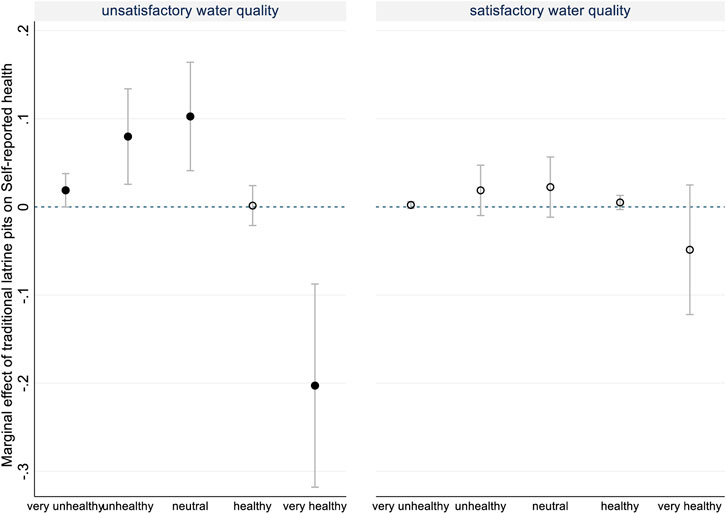
FIGURE 2. Marginal effects of traditional latrine pit use on health status of rural residents (by differences in water quality satisfaction). Note: Hollow circles indicate that the regression coefficients are not significant at the 10% significance level.
To further understand the extent to which each channel explains the impact of traditional latrine pit use and the total explanatory power thereof, this study draws on Gelbach (2016) and Gong et al. (2021) in employing a decomposition method. Specifically,
The following specification is considered, including all relevant mechanism variables in Eq. 1:
In accordance with Gelbach (2016):
This equation suggests that mechanism j’s component is
Figure 3 plots the estimated decomposition of the impact of traditional latrine pits on the health of rural residents in the areas of non-tap water sources, bad eating behaviors, and other factors. Non-tap water sources are found to explain approximately 18.48% of this effect, and bad eating behaviors explain around 5.98%.
3.4 Health value of flush toilets
Eq. 3 should be estimated before solving for the health value of flush toilets. Since the dependent variable is a sequence utility in the sequence model, it measures relative utility, while OLS is based on the assumption of cardinal utility, and its utility can be quantified. Therefore, a linear model is used to analyze the impact of flush toilets on the health of rural residents and estimate the corresponding monetization value V.
It is calculated that
4 Conclusion and policy implications
This paper uses field survey data from rural areas of Liaoning Province, China to investigate the impact of traditional latrine pit use on the health of rural residents. After controlling for individual, family, and village characteristics, it was found that traditional latrine pits were significantly negatively correlated with health. After using the PSM method to solve the possible sample self-selection and the resulting endogeneity problems, the obtained estimation results are robust. This study also finds that traditional latrine pits may affect health by polluting drinking water sources, the effects of which are exacerbated by poor eating habits. These two mechanisms collectively explain a significant part of the identified effects. Empirical results show that household use of tap water and improved dietary habits can significantly reduce these negative effects. Finally, analysis shows that the health value of flush toilets in the sample area accounts for 98% of the annual per capita household income. According to the results of this study, the following conclusions can be drawn:
First, when promoting the renovation of toilets to alleviate environmental pollution in rural areas, the government should take note of the close connection between toilet renovation and the health and well-being of people living in rural areas. Policymakers should increase investment in the renovation of rural toilets, explore diversified and stable financing mechanisms, and expand sources of funding for management and maintenance. Regional differences in the renovation of rural toilets are also important. Additionally, follow-up work is necessary, such as improving the supporting measures after the renovation of rural toilets, strengthening the centralized management and disposal of feces, improving the conversion efficiency of secondary energy, and ensuring the sustainability of the operation of facilities in order to avoid secondary pollution.
Second, decision-making departments should consider combining rural toilet renovation with other rural environmental infrastructure construction projects to promote mutual development. For example, it is necessary to continue to increase investment in safe drinking water facilities in rural areas, promote the upgrading of water supply facilities, and continue to increase the penetration rate of indoor tap water.
Finally, further efforts should be made to publicize the hazards of toilet pollution, so as to improve health awareness in rural areas. In this way, residents of these areas will be able to gradually change their unhygienic habits, and the demand for environmental health services will increase, allowing improved sanitation facilities to realize their full positive effect on human health.
There are several potential limitations in this study worth noting. First, the findings of this study are based on survey data that may be prone to measurement and reporting errors. Second, our sample is restricted to a single province in China. Nevertheless, we believe that the sample is representative and well-suited to test our theoretical predictions and represents an interesting case for analysis of a low-income setting. Further research using more representative data from different countries and regions is needed to test if the reported relationships hold in other settings and to further improve our understanding of decisions about determinants of health in developing countries.
Data availability statement
The data that support the findings of this study are available from Peking University but restrictions apply to the availability of these data, which were used under license for the current study, and so are not publicly available. Data are however available from the authors upon reasonable request and with permission of Peking University.
Ethics statement
The studies involving human participants were reviewed and approved by the Shenyang Agricultural University Institutional Review Board. The patients/participants provided their written informed consent to participate in this study.
Author contributions
Conceptualization, MZ and LH; methodology, LH; software, LH and SC; formal analysis, LH, SC and HW; writing—original draft preparation, LH; writing—review and editing, MZ and YH. All authors have read and agreed to the published version of the manuscript.
Funding
The authors disclosed receipt of the following financial support for the research, authorship, and publication of this article: Preparation of this manuscript was supported by Grant Nos. 71903133 and 71973100 from the National Natural Science Foundation of China.
Conflict of interest
The authors declare that the research was conducted in the absence of any commercial or financial relationships that could be construed as a potential conflict of interest.
Publisher’s note
All claims expressed in this article are solely those of the authors and do not necessarily represent those of their affiliated organizations, or those of the publisher, the editors and the reviewers. Any product that may be evaluated in this article, or claim that may be made by its manufacturer, is not guaranteed or endorsed by the publisher.
Footnotes
1Throughout this paper, sanitation improvement is defined as the use of flush toilets.
2Note that if unmeasured mechanisms are associated with observed mechanisms and/or if the observed mechanisms have measurement errors,
References
Abadie, A., and Imbens, G. W. (2016). Matching on the estimated propensity score. Econometrica 84 (2), 781–807. doi:10.3982/ecta11293
Adusumilli, N., Dikitanan, R., and Wang, H. (2020). Effect of cost-sharing federal programs on adoption of water conservation practices: Results from propensity score matching approach. Water Econ. Policy 6 (1), 1950004. doi:10.1142/s2382624x19500048
Agoramoorthy, G., and Hsu, M. J. (2009). India needs sanitation policy reform to enhance public health. J. Econ. Policy Reform 12 (4), 333–342. doi:10.1080/17487870903314625
Ali, A., Rahut, D. B., and Mottaleb, K. A. (2018). Improved water-management practices and their impact on food security and poverty: Empirical evidence from rural Pakistan. Water Policy 20 (4), 692–711. doi:10.2166/wp.2018.044
Anwar, W. A. (2003). Environmental health in Egypt. Int. J. Hyg. Environ. Health 206 (4-5), 339–350. doi:10.1078/1438-4639-00230
Bianco, K., Albano, R. M., de Oliveira, S. S., Nascimento, A. P. A., dos Santos, T., and Clementino, M. M. (2020). Possible health impacts due to animal and human fecal pollution in water intended for drinking water supply of Rio de Janeiro, Brazil. J. Water Supply Res. Technology-Aqua 69 (1), 70–84. doi:10.2166/aqua.2019.061
Caccio, S. M., and Chalmers, R. M. (2016). Human cryptosporidiosis in europe. Clin. Microbiol. Infect. 22 (6), 471–480. doi:10.1016/j.cmi.2016.04.021
Cameron, L., Chase, C., and Suarez, D. C. (2021). Relationship between water and sanitation and maternal health: Evidence from Indonesia. World Dev. 147, 105637. doi:10.1016/j.worlddev.2021.105637
Caruso, B. A., Freeman, M. C., Garn, J. V., Dreibelbis, R., Saboori, S., Muga, R., et al. (2014). Assessing the impact of a school-based latrine cleaning and handwashing program on pupil absence in nyanza province, Kenya: A cluster-randomized trial. Trop. Med. Int. Health 19 (10), 1185–1197. doi:10.1111/tmi.12360
Chen, Y. Y., and Jin, G. Z. (2012). Does health insurance coverage lead to better health and educational outcomes? Evidence from rural China. J. Health Econ. 31 (1), 1–14. doi:10.1016/j.jhealeco.2011.11.001
Cheng, S. K., Li, Z. F., Uddin, S. M. N., Mang, H. P., Zhou, X. Q., Zhang, J., et al. (2018). Toilet revolution in China. J. Environ. Manag. 216, 347–356. doi:10.1016/j.jenvman.2017.09.043
Clark, R., and Gundry, S. W. (2004). The prominence of health in donor policy for water supply and sanitation: A review. J. Water Health 2 (3), 157–169. doi:10.2166/wh.2004.0014
D'Agostino, R. B. (1998). Propensity score methods for bias reduction in the comparison of a treatment to a non-randomized control group. Stat. Med. 17 (19), 2265–2281. doi:10.1002/(sici)1097-0258(19981015)17:19<2265::aid-sim918>3.0.co;2-b
de Graaf, M., Beck, R., Caccio, S. M., Duim, B., Fraaij, P. L. A., Le Guyader, F. S., et al. (2017). Sustained fecal-oral human-to-human transmission following a zoonotic event. Curr. Opin. Virology 22, 1–6. doi:10.1016/j.coviro.2016.11.001
Fewtrell, L., Kaufmann, R. B., Kay, D., Enanoria, W., Haller, L., and Colford, J. M. (2005). Water, sanitation, and hygiene interventions to reduce diarrhoea in less developed countries: A systematic review and meta-analysis. Lancet Infect. Dis. 5 (1), 42–52. doi:10.1016/s1473-3099(04)01253-8
Foster, T., Falletta, J., Amin, N., Rahman, M., Liu, P. B., Raj, S., et al. (2021). Modelling faecal pathogen flows and health risks in urban Bangladesh: Implications for sanitation decision making. Int. J. Hyg. Environ. Health 233, 113669. doi:10.1016/j.ijheh.2020.113669
Fry, L. M., Mihelcic, J. R., and Watkins, D. W. (2008). Water and nonwater-related challenges of achieving global sanitation coverage. Environ. Sci. Technol. 42 (12), 4298–4304. doi:10.1021/es7025856
Gelbach, J. B. (2016). When do covariates matter? And which ones, and how much? J. Labor Econ. 34 (2), 509–543. doi:10.1086/683668
Genser, B., Strina, A., Teles, C. A., Prado, M. S., and Barreto, M. L. (2006). Risk factors for childhood diarrhea incidence - dynamic analysis of a longitudinal study. Epidemiology 17 (6), 658–667. doi:10.1097/01.ede.0000239728.75215.86
Gomez-Donate, M., Casanovas-Massana, A., Muniesa, M., and Blanch, A. R. (2016). Development of new host-specific Bacteroides qPCRs for the identification of fecal contamination sources in water. Microbiologyopen 5 (1), 83–94. doi:10.1002/mbo3.313
Gong, J., Lu, Y., and Song, H. (2021). Gender peer effects on students' academic and noncognitive outcomes evidence and mechanisms. J. Hum. Resour. 56 (3), 686–710. doi:10.3368/jhr.56.3.0918-9736r2
Hammer, J., and Spears, D. (2016). Village sanitation and child health: Effects and external validity in a randomized field experiment in rural India. J. Health Econ. 48, 135–148. doi:10.1016/j.jhealeco.2016.03.003
Hertzman, C., Power, C., Matthews, S., and Manor, O. (2001). Using an interactive framework of society and lifecourse to explain self-rated health in early adulthood. Soc. Sci. Med. 53 (12), 1575–1585. doi:10.1016/s0277-9536(00)00437-8
Idler, E. L., and Benyamini, Y. (1997). Self-rated health and mortality: A review of twenty-seven community studies. J. Health Soc. Behav. 38 (1), 21–37. doi:10.2307/2955359
Kmush, B. L., Walia, B., Neupane, A., Frances, C., Mohamed, I. A., Iqbal, M., et al. (2021). Community-level impacts of sanitation coverage on maternal and neonatal health: A retrospective cohort of survey data. BMJ Glob. Health 6 (10), 005674. doi:10.1136/bmjgh-2021-005674
Kumar, S., and Vollmer, S. (2013). Does access to improved sanitation reduce childhood diarrhea in rural India? Health Econ. 22 (4), 410–427. doi:10.1002/hec.2809
Loyola, S., Sanchez, J. F., Maguina, E., Canal, E., Castillo, R., Bernal, M., et al. (2020). Fecal contamination of drinking water was associated with diarrheal pathogen carriage among children younger than 5 Years in three Peruvian rural communities. Am. J. Trop. Med. Hyg. 102 (6), 1279–1285. doi:10.4269/ajtmh.19-0337
Mara, D., Lane, J., Scott, B., and Trouba, D. (2010). Sanitation and health. PLoS Med. 7 (11), e1000363. doi:10.1371/journal.pmed.1000363
Miao, Y. Q., Yang, Z. B., and Zhou, H. Y. (2012). Research on willingness to pay and influencing factors of rural residents' environmental sanitation improvement-Taking toilet improvement as an example. J. Manag. World (In Chin. 09, 89–99.
O'Gorman, M. (2021). Mental and physical health impacts of water/sanitation infrastructure in First Nations communities in Canada: An analysis of the Regional Health Survey. World Dev. 145, 105517. doi:10.1016/j.worlddev.2021.105517
Odagiri, M., Schriewer, A., Daniels, M. E., Wuertz, S., Smith, W. A., Clasen, T., et al. (2016). Human fecal and pathogen exposure pathways in rural Indian villages and the effect of increased latrine coverage. Water Res. 100, 232–244. doi:10.1016/j.watres.2016.05.015
Speich, B., Croll, D., Furst, T., Utzinger, J., and Keiser, J. (2016). Effect of sanitation and water treatment on intestinal protozoa infection: A systematic review and meta-analysis. Lancet Infect. Dis. 16 (1), 87–99. doi:10.1016/s1473-3099(15)00349-7
Suparman, Y., Folmer, H., and Oud, J. H. L. (2016). The willingness to pay for in-house piped water in urban and rural Indonesia. Pap. Regional Sci. 95 (2), 407–426. doi:10.1111/pirs.12124
Ulukanligil, M., and Seyrek, A. (2003). Demographic and parasitic infection status of schoolchildren and sanitary conditions of schools in Sanliurfa, Turkey. BMC Public Health 3, 29. doi:10.1186/1471-2458-3-29
van Praag, B. M. S., and Baarsma, B. E. (2005). Using happiness surveys to value intangibles: The case of airport noise. Econ. J. 115 (500), 224–246. doi:10.1111/j.1468-0297.2004.00967.x
Waddington, H., and Snilstveit, B. (2009). Effectiveness and sustainability of water, sanitation, and hygiene interventions in combating diarrhoea. J. Dev. Eff. 1 (3), 295–335. doi:10.1080/19439340903141175
Wang, S. H., Chen, M., and Song, M. L. (2018). Energy constraints, green technological progress and business profit ratios: Evidence from big data of Chinese enterprises. Int. J. Prod. Res. 56 (8), 2963–2974. doi:10.1080/00207543.2018.1454613
Wang, S. H., Sun, X. L., and Song, M. L. (2021). Environmental regulation, resource misallocation, and ecological efficiency. Emerg. Mark. Finance Trade 57 (3), 410–429. doi:10.1080/1540496x.2018.1529560
Wang, S. H., Wang, X. Q., and Lu, B. B. (2022). Is resource abundance a curse for green economic growth? Evidence from developing countries. Resour. Policy 75, 102533. doi:10.1016/j.resourpol.2021.102533
Wannamethee, G., and Shaper, A. G. (1991). Self-assessment of health-status and mortality in middle-aged British men. Int. J. Epidemiol. 20 (1), 239–245. doi:10.1093/ije/20.1.239
Wen, Z. K., and Yang, Y. (2005). Analysis of economic and social benefits of latrine reconstruction in rural areas of Hunan province. Chin. Prim. Health Care 19, 76–78. (In Chinese).
World Health Organization & United Nations Development Programme (2007). Economic and health effects of increasing coverage of low cost household drinking-water supply and sanitation interventions to countries off-track to meet MDG target 10: Background document to the "human development report 2006. Geneva, GE: World Health Organization.
Zhao, L. G., Deng, X. J., and Wang, X. Y. (2018). Socioeconomic status, sanitation facilities and rural residents' health. Issues Agric. Econ. (In Chinese) 7, 96–107.
Zhou, W. L., Gu, Y. W., and Wang, X. L. (2021). Access to sanitary toilets and health outcomes: A panel data analysis using two-way fixed effects model. Math. Biosci. Eng. 18 (6), 8815–8830. doi:10.3934/mbe.2021435
Keywords: sanitation improvement, water quality, health knowledge, water pollution, China
Citation: Huang L, Chen S, Wu H, He Y and Zhou M (2022) Implications of sanitation for rural resident health: Evidence and mechanisms. Front. Environ. Sci. 10:1060558. doi: 10.3389/fenvs.2022.1060558
Received: 03 October 2022; Accepted: 26 October 2022;
Published: 21 November 2022.
Edited by:
Shuhong Wang, Shandong University of Finance and Economics, ChinaReviewed by:
Zhibo Zhao, Qilu University of Technology, ChinaYuanxiang Zhou, Anhui University of Finance and Economics, China
Copyright © 2022 Huang, Chen, Wu, He and Zhou. This is an open-access article distributed under the terms of the Creative Commons Attribution License (CC BY). The use, distribution or reproduction in other forums is permitted, provided the original author(s) and the copyright owner(s) are credited and that the original publication in this journal is cited, in accordance with accepted academic practice. No use, distribution or reproduction is permitted which does not comply with these terms.
*Correspondence: Mi Zhou, emhvdW1pMjAxMUBzeWF1LmVkdS5jbg==
 Li Huang
Li Huang Shupeng Chen
Shupeng Chen